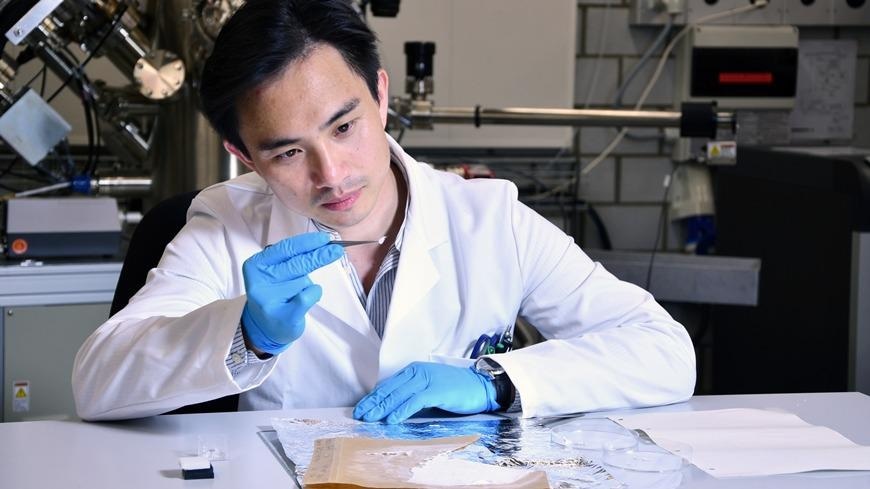A bandage capable of releasing medication the moment an infection begins in a wound could treat injuries in a much better way. Scientists at Empa are now experimenting with polymer fibers that soften when the location heats up because of an infection, thereby discharging antimicrobial drugs.
 Empa researcher Fei Pan is working on a membrane made of nanofibers that releases medication only when the material heats up. Such a membrane could, for example, become active in a bandage as soon as an inflammation starts. Image Credit: Empa.
Empa researcher Fei Pan is working on a membrane made of nanofibers that releases medication only when the material heats up. Such a membrane could, for example, become active in a bandage as soon as an inflammation starts. Image Credit: Empa.
It is tough to see from the outside if a wound will heal without issues under the dressing or if bacteria will enter the injured area and trigger inflammation. To be safe, antibiotics or disinfectant ointments are applied to the wound prior to the application of the dressing.
However, these preventive strategies are not needed in all cases. Thus, there is a wastage of medications and injuries are over-treated.
What is worse, the wasteful application of antibiotics increases the rise of multi-resistant germs, which are a huge issue in global healthcare. Researchers at Empa working in two Empa laboratories Biointerfaces and Biomimetic Membranes and Textiles in St. Gallen want to alter this. They are creating a wound dressing that autonomously imparts antibacterial drugs only when they are truly required.
The idea of the interdisciplinary team headed by Fei Pan and Qun Ren: The bandage should be "loaded" with medicine and react to environmental triggers.
In this way, wounds could be treated as needed at exactly the right moment.
Fei Pan, Study Lead and Scientist, Empa
As an environmental trigger, the researchers selected a well-recognized effect: the increase in temperature in an infected, inflamed injury.
Perfect Mixture
The researchers then had to prepare a material that would react suitably to this rise in temperature.
Therefore, a skin-friendly polymer composite was prepared with many components: acrylic glass [polymethyl methacrylate (PMMA)], which is used, for instance, in the textile sector and for eyeglass lenses, and Eudragit, a biocompatible polymer combination that is employed, for instance, to coat pills. Electrospinning was applied to process the polymer combination into a thin membrane of nanofibers.
Lastly, octenidine was enclosed in the nanofibers as a medically active constituent. Octenidine is an antiseptic that acts rapidly against fungi, bacteria and certain viruses. In the health sector, it can be applied on mucous membranes, on the skin, and for wound sterilization.
Shattering Glove
In order for the membrane to act as a "smart bandage" and actually release the disinfectant when the wound heats up due to an infection, we put together the polymer mixture of PMMA and Eudragit in such a way that we could adjust the glass transition temperature accordingly.
Fei Pan, Study Lead and Scientist, Empa
This is the temperature when a polymer turns from a solid-state to a rubbery, fortified state. Figuratively, the effect is frequently defined in reverse: If a rubber glove is put in liquid nitrogen at –196 degrees, it alters its consistency and turns so hard that it can shatter like glass with a single blow.
On the other hand, the preferred glass alteration temperature of the polymer membrane was in the range of 37 degrees. When inflammation begins and the skin starts to heat up above its regular temperature of 32 to 34 degrees, the polymer alters from its solid state to a softer consistency. In lab experiments, the researchers noticed the antiseptic being discharged from the polymer at 37 degrees – but not at 32 degrees.
Another benefit: The procedure is reversible and can be carried out again and again up to five times, as the procedure always "switches itself off" when the temperature drops.
Following these encouraging preliminary tests, the Empa scientists at present want to enhance the effect. Rather than a temperature range of 4 to 5 degrees, the smart bandage should already turn on and off at lower temperature differences.
Smart and Unsparing
To examine the effectiveness of the nanofiber membranes against wound microorganisms, more lab experiments are being scheduled. Qun Ren, the study team leader has long been worried about germs that settle in the interface between surfaces and the environment, for example, on a skin injury.
"In this biological setting, a kind of no man's land between the body and the dressing material, bacteria find a perfect biological niche," says the Empa scientist.
Communicable agents such as Pseudomonas or staphylococci bacteria can cause serious wound healing illnesses. It was indeed these wound germs that the researchers allowed to become familiar with the smart bandage in the Petri dish. Furthermore, the number of bacteria was decreased approximately 1000-fold when octenidine was discharged from the smart dressing.
With octenidine, we have achieved a proof of principle for controlled drug release by an external stimulus.
Qun Ren, Study Lead and Scientist, Empa
Qun Ren states that the technology could be applied in the future to other kinds of drugs, boosting the efficiency and precision of their dosage.